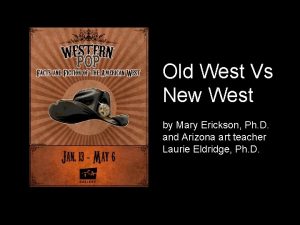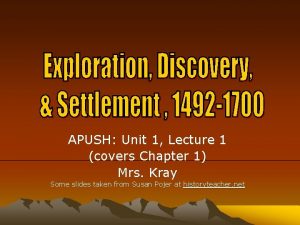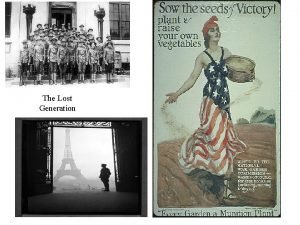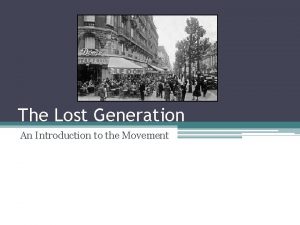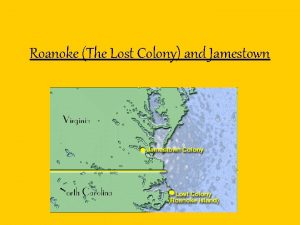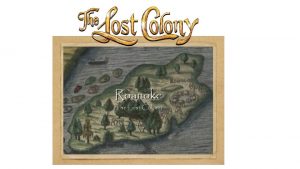How the West was WonOR Lost APUSH Unit









































































- Slides: 73

“How the West was Won…OR Lost” APUSH Unit 4

"My lands are where my dead lie buried" -Crazy Horse "I wish it to be remembered that I was the last man of my tribe to surrender my rifle. " -Sitting Bull “Hurrah, boys! We've got them!” - General George Custer at the Battle of Little Big Horn

The “New South” After Reconstruction ended in 1877, the South struggled to develop its industry Positives ◦ Cities grew ◦ Industry grew ◦ Railroads grew Negatives ◦ Lack of capital and labor Few trained workers Low wages ◦ Most money in few hands ◦ Education requirements were few



A Crisis in Farming Cash crops had lost value in the South Cotton still important, but European factories were now thriving and took profits from southern planters The Farmer’s Alliance was formed to help the struggles ◦ Tried to get better rates from railroads




Civil Rights Advancements and Losses Advances Losses � 13 th Amendment � 14 th Amendment � 15 th Amendment � The Farmer’s � Terror groups � Black codes � Several civil rights cases Alliance � The Civil Rights Act of 1875 in the Supreme Court reduced the power of the amendments resulting in stringent state laws concerning ◦ Segregation ◦ Grandfather clauses ◦ White primaries

The Boll Weevil Small beetles that feed on cotton leaves The boll weevil has caused an estimated $14 billion loss in yield to the U. S. cotton industry since it arrived from Mexico in 1892. Programs to eliminate boll weevils have led to its total eradication in several cotton producing states.

The Ballad of the Boll Weevil The Boll Weevil is a little black bug come from Mexico they say All the way from Texas, just a-lookin’ for a place to stay Just a-lookin’ for a home, just a-lookin’ for a home � The first time I saw the boll weevil he was sitting in the square The next time I saw the boll weevil he had his whole family there Just a-lookin’ for a home � The farmer took the boll weevil and put him in the hot sand The boll weevil said “This is mighty hot but I’ll stand in it like a man” This’ll be my home � The farmer took the boll weevil and put him in a lump of ice The weevil said to the farmer ” Man! This is mighty cool and nice” This’ll be my home � The boll weevil said to the farmer “You can ride that Ford machine But when I get through with your cotton field you won’t buy no gasoline You won’t have no home” � The merchant got half the cotton the boll weevil got the rest He didn’t leave that farmer’s wife but one old cotton dress And it was full of holes � The Boll Weevil is a little black bug come from Mexico they say All the way from Texas just alookin’ for a place to stay � http: //www. ibiblio. org/jimmy/folkden-wp/? p=7092

Turner’ Frontier Thesis � Frederick Jackson Turner theorized in 1893 that the frontier had played a central role in forming the American character ◦ This included the idea that the frontier had produced individualistic, restless, and socially mobile Americans who were ready for adventure � These individuals in Turner’s thesis were white men only and disregarded the impact that women and minorities made in establishing the American West

Railroads and Settlers � Railroads brought swarms of settlers, who took Native American lands � Some signed treaties, selling their lands and went to reservations � Others fought, or did not stay on the reservations


Face-Off Between the Cultures The Second Sioux War began in 1875 when miners went to the Black Hills in South Dakota and Chief Sitting Bull left the reservation again ◦ The American Army was called in to bring him back…they called on General George Custer for the job

Sitting Bull was the Native American chief under whom the Sioux tribes united in their struggle for survival on the North American Great Plains. Following the discovery of gold in the Black Hills of South Dakota in 1874, the Sioux came into increased conflict with U. S. authorities in the Sioux Wars. Sitting Bull was given the name Tatanka-Iyotanka, which describes a buffalo bull sitting intractably on its haunches.

Geronimo � Famous Apache warrior ◦ Was born in 1829 in what today is New Mexico � After the area was claimed by the US, Geronimo led a band of Apache against these “outsiders” in 1865. � He continued to fight for freedom in battles against the U. S. and Mexican forces.

Geronimo � Geronimo's final surrender in 1886 was the last significant Indian action in the United States. � At the end, his group consisted of only 16 warriors, 12 women, and 6 children. � Upon their surrender, Geronimo was sent to Florida and Alabama. � He died in 1909 and was buried in Oklahoma.

Land for Sale!! v Pacific Railway Acts of 1862 and 1864 gave the Union Pacific and Central Pacific railroad companies 10 square miles on each side of the tracks. v. They sold land to settlers who wanted farms v Very profitable for railroads AND the lucky few who got this land


Cheap Land for Sale �Homestead Act, 1862: offered 160 acres of land to those who met these requirements: 1. 21 years old 2. American citizens or have filed for citizenship 3. Pay $10 4. Build a house and live in it at least 6 months a year 5. Farm the land for 5 consecutive years �Problems: �Many were too poor, with no farming experience �Some fraud in obtaining land


Settlers Work Together � Water was scarce, contaminated � 1880 s had well-drilling equipment ◦ This was very difficult; backbreaking labor � Men often had to leave and work in towns for cash, leaving families alone � Families cooperated in building houses, barns, sewing quilts, cornhusking, caring for the sick Sod House on Prairie

Land for Colleges �Morrill Land-Grant Act of 1862 �Provided support for state colleges �The federal government distributed millions of acres of western lands to state governments �The land was sold to fund agricultural colleges


African Americans in the West � Exodusters ◦ 50, 000 African Americans who moved to the West ◦ Benjamin “Pap” Singleton led a group � Life was hard due to poverty, lack of experience with prairie crops like wheat and corn � However, most Exodusters were happier than if they had stayed in the South ◦ Many there still subjected to Black codes and inequality

Women on the Frontier � Men often had to leave “Here we are, boys!!” to find jobs for cash ◦ Women often spent long periods alone ◦ Women stayed to protect homestead from squatters � Western women led the fight for the right to vote ◦ 1890 Wyoming was the first state to give women the right to vote

General George A. Custer Flamboyant in life, George Armstrong Custer has remained one of the bestknown figures in American history. He fought during the Civil War in the First Battle of Bull Run, and served in the Virginia and Gettysburg campaigns. Although his units suffered enormously high casualty rates -- even by the standards of the bloody Civil War

“There’s Gold in them there Black Hills!” When Custer reported finding gold in the Black Hills, the government offered to buy the land from the Sioux, but they refused to sell. The U. S. Army then allowed gold prospectors to come into the Reservation's hills by the thousands. Gold miners in the Black Hills of Dakota

The Black Hills of North Dakota

The 2 Leaders Meet � In the summer of 1876 Custer was sent from Fort Abraham Lincoln to capture Sitting Bull and his band of Sioux � On the verge of what seemed to him a certain and glorious victory for both the United States and himself, Custer ordered an immediate attack on a Sioux village.


Custer is Surrounded and. . . � Contemptuous of Indian military power, Custer split his forces into three parts to ensure that fewer Indians would escape. � But the plan failed, and on June 25, he and his troopers were attacked at Little Big Horn in a battle that probably lasted no longer than twenty minutes. Battle of Little Big Horn

Custer’s Last Stand The attack was one the greatest fiascos of the United States Army. Thousands of Lakota, Cheyenne and Arapaho warriors forced Custer's unit back onto a long, dusty ridge parallel to the Little Bighorn, surrounded the soldiers and killed all 200+ American soldiers.

Paintings of Little Big Horn usually depict Custer as a gallant victim, surrounded by bloodthirsty savages intent upon his annihilation.

The Battlefield Today

They Won the Battle, but Lost their Culture Sitting Bull thought by winning this battle, the U. S. government would leave him alone, but the fight had just begun. Most of Indians present were forced to surrender within a year of their greatest battlefield triumph.

Sitting Bull’s Later Years � Sitting Bull was held as a prisoner of war for two years. � In 1885, Sitting Bull joined Buffalo Bill's Wild West Show and traveled throughout the United States and Canada.

Crazy Horse was a legendary Lakota (Sioux) warrior Crazy Horse earned his reputation not only by his skill and daring in battle but also by his fierce determination to preserve his people's traditional way of life. There are no pictures of Crazy Horse…he never allowed it.

The Fate of Indian Territory Nearly 70 Indian nations were forced onto Indian Reservations and Native American cultures were shattered ◦ Farming tribes were left with no land to farm ◦ Herding tribes were left with no land to herd In 1889 Congress opened the confiscated 2 million acres to settlers Some Indian leaders led rebellions to no avail

The Battle of Rosebud Creek When the War Department ordered all Lakota bands onto their reservations in 1876 Crazy Horse became a leader of the resistance. He gathered a force of Sioux and Cheyenne at his village and turned back American force near Little Big Horn.

The Death of Crazy Horse He was killed on September 6 under strange circumstances at Fort Robinson, Nebraska. He fought his entire life for the preservation of the land culture of the Sioux Indians.

South Dakota… Home to Two Monuments

Crazy Horse Monument The Crazy Horse Memorial is a memorial to the famous Native American leader The form is of a huge statue of the rider on horseback carved from the side of a mountain. http: //www. crazyhorse. org/

Plans for the Sculpture When completed, the Crazy Horse statue will have some extremely impressive dimensions � It will be larger than the Sphinx, at 563 feet it will be taller than the Washington Monument � The figure's outstretched arm will be longer than three American Football fields. � Model of Statue


Chief Joseph and the Nez Perce The Nez Perce tribe was located in what is today Oregon and Washington When young members of the tribe attacked white settlers, the settlers vowed to get revenge They fled, but were attacked by US troops at Big Hole Basin ◦ Men, women, and children were killed

Chief Joseph and the Nez Perce Chief Joseph tried to escape with his people and got to within 40 miles of Canada when he was captured in 1877 ◦ “I am tired of fighting” Finally settled on a reservation on the Colville Reservation in Washington State Chief Joseph’s route as he was pursued by American troops

The Dawes Act � In February 1887, Congress passed the Dawes Plan. ◦ The plan said that Native Americans should be granted land in exchange for renouncing tribal allegiances. � Under the terms of this legislation all family heads received one hundred acres, and each dependent child 40 acres.


Results of Dawes Act The Dawes Act was disastrous for most Native Americans. ◦ The Act forced Native people onto small tracts of land distant from their kin relations. ◦ The allotment policy depleted the land base, ending hunting as a means of subsistence. ◦ Traditionally women were the agriculturists while the men were the hunters and warriors. Far from making them self-reliant farmers, it shattered one of the main pillars of their culture--community property.


The Boomers and Sooners At noon on April 22, hundreds of homesteaders rushed across the border At high noon on April 22, 1889, the opening was what would soon become Oklahoma Territory. ◦ The settlers were known as Boomers; those who sneaked in early were known as Sooners. http: //www. ci. norman. ok. us/li nks/boomer_sooner. htm

The Ghost Dance � When Sitting Bull returned to the reservation in 1889, many natives had joined a new religion called the Ghost Dance. � They believed an Indian messiah would return their lands and remove the whites.


Excerpt from the Ghost Dance “Dance”, said the dream. “Dance to call those ghosts alive again. ” “Dance, and the white men will all disappear, their horses and their goods remain. ” “Dance, and the fish will fill the streams and buffalo be many. ” “Dance. ” Ghost Dance by Robbie Robertson https: //www. youtube. com/watch? v=w. TY 2 pm. Kgu. Dg

Massacre at Wounded Knee White officials became alarmed at the religious fervor and activism and in December 1890 banned the Ghost Dance on Lakota reservations. When the rites continued, officials called in troops to the reservations in South Dakota at Wounded Knee.


Massacre at Wounded Knee The resulting massacre, which lasted less than an hour, found at least 150 Indians had been killed and 50 wounded. � In comparison, army casualties were 25 killed and 39 wounded.


The Death of Sitting Bull � Because of this new religion, Indian police arrested Sitting Bull on December 15, 1890 as a precaution. � They planned to send Sitting Bull to prison, but when his warriors attempted to rescue him, he was killed. � He was buried at Fort Yates. � In 1953, his remains were moved to Mobridge, South Dakota.

Native Cultures Destroyed Most leaders dead or under arrest � Buffalo killed off � Native Americans are forbidden to practice their religions � The abuse of the Dawes Act resulted in the loss of much of their lands • The amount of land owned by Indians shrank by 65% by 1934. �

Indian Boarding Schools The boarding school experience for Indian children began in 1860 when the Bureau of Indian Affairs established the first Indian boarding school on the Yakima Indian Reservation in the state of Washington. The goal of these reformers was to use education as a tool to “assimilate” Indian tribes into the mainstream of the “American way of life”. Carlisle Indian School in Carlisle, PA

Before/ “After” Pictures

Farming on the Plains � Challenging conditions � New technology-dry farming, planting crops that do not require much water � Agricultural knowledge � Bonanza farms: controlled by big businesses � Farm debt: machines were costly, land speculation, and low prices for crops

Mining Frontier � Gold was first discovered at Sutter’s Mill in CA � Pikes Peak � Comstock Lode � Placer mining: shoveled dirt into a pan and washed it in water, looking for gold or silver � Large corporations moved in for PROFIT!

The Cattle Industry � American “cowboys” adopted Mexican ranching ways, equipment, and dress. ◦ There was a huge demand for beef � Cattle were transported from ranges to “cow towns” on “Long drives” � The Chisholm Trail linked Texas to Kansas and the railroad � Barbed wire ended the open range

Farmers’ Complaints � There was a decline in crop prices ◦ Competition from farmers ◦ Competition from other countries � Complaints about the power of big business � The government refused of to help farmers and usually sided with big business


The West by 1900 Number of tenant farmers grew in the West Corporations owned many large farms Farmers were deeply in debt Census of 1890: frontier ended

The 3 rd Bestselling Book in American History (at the Time) Looking Backward by Edward Bellamy The main character goes to sleep in 1887 and wakes up in his city 113 years later to discover that the old society and all evils have been swept away. By 2000 the universal reign of brotherhood has arrived- total employment and early retirement for all. It is one of the few books ever published that created almost immediately on its appearance a political mass movement- nationalism.

Look Backwards AND Forwards as you study for the Unit 4 A Test!
 Luke 15:11-35
Luke 15:11-35 West north west wind direction
West north west wind direction Name of the wind series
Name of the wind series West oost zuid noord
West oost zuid noord East is east and west is west
East is east and west is west Old west vs new west
Old west vs new west Unit 6 review questions
Unit 6 review questions Hát kết hợp bộ gõ cơ thể
Hát kết hợp bộ gõ cơ thể Lp html
Lp html Bổ thể
Bổ thể Tỉ lệ cơ thể trẻ em
Tỉ lệ cơ thể trẻ em Voi kéo gỗ như thế nào
Voi kéo gỗ như thế nào Thang điểm glasgow
Thang điểm glasgow Chúa yêu trần thế
Chúa yêu trần thế Các môn thể thao bắt đầu bằng tiếng đua
Các môn thể thao bắt đầu bằng tiếng đua Thế nào là hệ số cao nhất
Thế nào là hệ số cao nhất Các châu lục và đại dương trên thế giới
Các châu lục và đại dương trên thế giới Công của trọng lực
Công của trọng lực Trời xanh đây là của chúng ta thể thơ
Trời xanh đây là của chúng ta thể thơ Mật thư anh em như thể tay chân
Mật thư anh em như thể tay chân Phép trừ bù
Phép trừ bù độ dài liên kết
độ dài liên kết Các châu lục và đại dương trên thế giới
Các châu lục và đại dương trên thế giới Thơ thất ngôn tứ tuyệt đường luật
Thơ thất ngôn tứ tuyệt đường luật Quá trình desamine hóa có thể tạo ra
Quá trình desamine hóa có thể tạo ra Một số thể thơ truyền thống
Một số thể thơ truyền thống Cái miệng xinh xinh thế chỉ nói điều hay thôi
Cái miệng xinh xinh thế chỉ nói điều hay thôi Vẽ hình chiếu vuông góc của vật thể sau
Vẽ hình chiếu vuông góc của vật thể sau Biện pháp chống mỏi cơ
Biện pháp chống mỏi cơ đặc điểm cơ thể của người tối cổ
đặc điểm cơ thể của người tối cổ Giọng cùng tên là
Giọng cùng tên là Vẽ hình chiếu đứng bằng cạnh của vật thể
Vẽ hình chiếu đứng bằng cạnh của vật thể Vẽ hình chiếu vuông góc của vật thể sau
Vẽ hình chiếu vuông góc của vật thể sau Thẻ vin
Thẻ vin đại từ thay thế
đại từ thay thế điện thế nghỉ
điện thế nghỉ Tư thế ngồi viết
Tư thế ngồi viết Diễn thế sinh thái là
Diễn thế sinh thái là Dot
Dot Các số nguyên tố là gì
Các số nguyên tố là gì Tư thế ngồi viết
Tư thế ngồi viết Lời thề hippocrates
Lời thề hippocrates Thiếu nhi thế giới liên hoan
Thiếu nhi thế giới liên hoan ưu thế lai là gì
ưu thế lai là gì Khi nào hổ mẹ dạy hổ con săn mồi
Khi nào hổ mẹ dạy hổ con săn mồi Sự nuôi và dạy con của hổ
Sự nuôi và dạy con của hổ Hệ hô hấp
Hệ hô hấp Từ ngữ thể hiện lòng nhân hậu
Từ ngữ thể hiện lòng nhân hậu Thế nào là mạng điện lắp đặt kiểu nổi
Thế nào là mạng điện lắp đặt kiểu nổi Apush period 3 review
Apush period 3 review Unit 6 apush review
Unit 6 apush review Jeremiad apush
Jeremiad apush Surrogate families apush
Surrogate families apush Apush unit 1
Apush unit 1 Surplus keuangan adalah
Surplus keuangan adalah Hyp opp adj
Hyp opp adj Si units mass
Si units mass Algebra 2 unit 1 test
Algebra 2 unit 1 test Contoh soal perhitungan unit cost rumah sakit
Contoh soal perhitungan unit cost rumah sakit Unit process and unit operation
Unit process and unit operation Difference between unit process and unit operation
Difference between unit process and unit operation Setiap unit akuntansi dianggap sebagai unit yang mandiri
Setiap unit akuntansi dianggap sebagai unit yang mandiri The lost children of rockdale county
The lost children of rockdale county Lost mountain middle school death
Lost mountain middle school death Lost at sea ranking chart
Lost at sea ranking chart Lost wax pattern technique
Lost wax pattern technique Open english
Open english Simon woke up early and is very sleepy now
Simon woke up early and is very sleepy now Who lost territory after ww1
Who lost territory after ww1 Why is the lost generation called that
Why is the lost generation called that The lost leader summary
The lost leader summary The lost generation years
The lost generation years Lost generation ww1
Lost generation ww1 The lost generation facts
The lost generation facts





